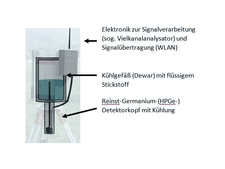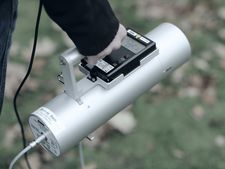-
Topics
subnavigation
Topics
Electromagnetic fields
- What are electromagnetic fields?
- Static and low-frequency fields
- Radiation protection relating to the expansion of the national grid
- High-frequency fields
- Radiation protection in mobile communication
Optical radiation
Ionising radiation
- What is ionising radiation?
- Radioactivity in the environment
- Applications in medicine
- Applications in daily life and in technology
- Effects
- What are the effects of radiation?
- Effects of selected radioactive materials
- Consequences of a radiation accident
- Cancer and leukaemia
- Genetic radiation effects
- Individual radiosensitivity
- Epidemiology of radiation-induced diseases
- Ionising radiation: positive effects?
- Risk estimation and assessment
- Radiation protection
- Nuclear accident management
- Service offers
-
The BfS
subnavigation
The BfS
- About us
- Science and research
- Laws and regulations
- BfS Topics in the Bundestag
- Links
Measurements systems and software
- In a radiological emergency, mobile and stationary measurement systems are used.
- The BfS has developed special programs for collecting and analysing the data gathered through the various measurement systems.
In the early phase of a potential radiological incident, the BfS exclusively uses automatic stationary and quasi-stationary gamma dose rate (ODL) measurement systems.
After the radiological situation has become stable and no more releases are expected, complementary measurements provide a more refined picture of the radiological situation. To this end, the BfS applies mobile measurement systems.
Four different types of measurement systems are held available altogether.
Measurement systems in helicopters
Measurement systems in helicopters
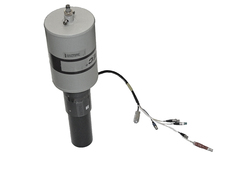
![]() High-purity germanium detector (HPGe)
High-purity germanium detector (HPGe)
For measurement flights, helicopters are fitted with special equipment for the detection of gamma-emitting radionuclides.
Two different types of detectors are used for this purpose: On the one hand there is a high-purity germanium detector for the safe identification of radioactive substances, on the other hand there are up to four sodium iodide detectors for detecting radioactive sources and radiation anomalies as well as for determining the gamma dose rate.
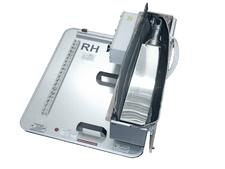
![]() Sodium iodide detector (NaI (Tl) detector)
Sodium iodide detector (NaI (Tl) detector)
Owing to the high sensitivity of sodium iodide detectors, spectra can quickly be recorded and analysed. During a one-second measurement cycle, at a flight speed of 100 kilometres per hour, a distance of about 28 metres is covered.

![]() Sum spectra of a germanium detector and a NaI(Tl) detector from the "Biblis" measurement flight
Sum spectra of a germanium detector and a NaI(Tl) detector from the "Biblis" measurement flight
Due to the low probability of detection, however, the measurement cycles with germanium detectors can last several tens of seconds while the natural radioactivity in the environment is being mapped.
Using the radar altimeter integrated in the helicopter, the flight altitudes and the geographic coordinates (GPS) are also recorded in addition to the measurement spectra during every measurement cycle. This clear allocation of the geographic coordinates to the measurement data allows the radiological mapping of the measurement areas overflown.
Other measuring instruments such as a gamma dose rate monitor can additionally be installed in the helicopter. In that way, the helicopter crew can stay informed about the current dose rate or accrued dose at any time during the measurement flight.
Car-borne
Mobile in-situ mesurement systems
To detect radionuclides in soil "in situ" - in other words on site and without sampling - the type of radiation emitted during the decay of the radionuclides is analysed. The radiation type is characteristic of the particular process. The type of emitted particles and their energy(-distribution) are sort of a "fingerprint" of a radionuclide.
In-situ gamma spektroscopy
In situ gamma spectroscopy uses almost exclusively measurement systems where the main component is made up of a detector head filled with high purity germanium (abbreviated HPGe). The energy of the gamma radiation is converted into electrical impulses. Using a multichannel analyser, the pulse height is processed and a spectrum is created.
HPGe detectors are distinguished by a very good energy resolution which, however, can only be obtained through strong cooling (about -196 degrees Celsius). Large volume detectors and long measurement periods also allow the detection of very small quantities of radionuclides.
Mobile ODL
Mobile gamma dose rate (ODL) for measurements while driving
The BfS employs a large volume NBR (natural background reduction) system for gamma dose rate (ODL) measurements while driving.
The system uses a special method to distinguish between artificial and naturally occurring radioactive radiation. In the process, the system detects gamma radiation in various energy ranges and compares the measured values. If the measured spectrum deviates from the previously registered natural spectrum, this deviation indicates artificial activity.
Backpack-borne gamma dose rate (ODL) measurement systems for small-scale mapping
The mobile measurement system is made up of a calibratable scintillation probe combined with a GPS mouse and a laptop.
The following data are supplied to a program developed by the BfS:
- the gamma dose rate (1 value per second) measured by the probe as well as
- the geographical position,
- the speed and
- the geographical altitude of a connected GPS mouse.
At one-minute intervals, the data can be automatically transferred to one of the six central data servers of the BfS gamma dose rate measuring network (ODL measuring network) via mobile connection and can be fed into a database. The position and the measured gamma dose rate of the measurement systems involved can be observed online by the staff on site and at the BfS Coordinating Office. If necessary, they can alter the route via mobile phone or order measurements on a smaller scale in a certain location.
ODL-Probes
Stationary and quasi-stationary gamma dose (ODL) probes
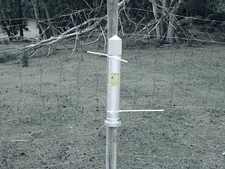
![]() Temporarily constructed quasi-stationary probe
Temporarily constructed quasi-stationary probe
The ODL measuring network comprises stationary probes with wired connections for power supply and data transfer. So-called quasi-stationary gamma dose rate (ODL) probes are held available as well. These are mobile probes with a self-contained power supply. In the event of an incident, the measuring network can be densified with these probes in a potentially affected area. In this way assessments of the radiological situation on a smaller scale are possible. The overall picture becomes more accurate.
Design and functional principle of the measuring probes
The stationary and quasi-stationary gamma dose rate (ODL) probes are of largely identical design. They consist of two Geiger-Müller counter tubes. The counter tubes are filled with gas and are located in an electric field. When particles strike the tube wall, a voltage pulse is generated and is counted afterwards. The gas-filled counter tubes are sized differently and thus allow an extremely wide measurement range between about 0.04 microsievert per hour and 5 sieverts per hour.
The low-dose counter
The sensitive so-called low-dose counter permits the determination of the gamma dose rate (ODL) within the range of background radiation. This is the range around natural environmental radioactivity which is typically between 0.04 and 0.25 microsievert per hour in Germany and Europe.
The high-dose counter
In order to be prepared for all scenarios, the second so-called high-dose counter allows measurements of the gamma dose rate (ODL) of up to 5 sieverts per hour.
A total value of environmental radioactivity without discriminating between different radionuclides is determined from the data generated by the gamma dose rate (ODL) probes..
Gamma dose rate (ODL) spectrometer probes
A gamma dose rate (ODL) spectrometer probe is used for the energy dependent recording of gamma and X-radiation. In a scintillation detector, for example, the radiation energy is converted into light pulses. The light is amplified and is processed to an analogue electrical signal. This signal is converted to a digital value and is further processed. If these signals are recorded over a longer period - for example 30 minutes - a spectrum is created. This spectrum provides information about which radionuclides are involved and in what intensity.
Measurement and evaluation software
The BfS has developed several programs for recording and further processing data during the flight.
- Control Flight Server (CFS): All hardware components within the measurement system can be controlled using the program.
- Programmable Interface for Spectrometry Applications (PISA): PISA can be used to initiate and terminate measurements and to display and save the measurement parameters set as well as the recorded measurement data.
- Rohflug (German name of the program): The program allows a first, detailed evaluation of the measurement data directly after the helicopter has landed.
Control Flight Server (CFS)
Control Flight Server (CFS)
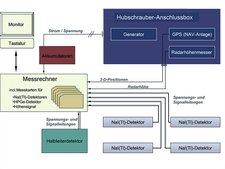
![]() Schematic illustration of the airborne-gamma spectrometry measurement system
Schematic illustration of the airborne-gamma spectrometry measurement system
When the program is called, ASCII files containing all parameter definitions for
- the detectors used,
- the dose rate meter,
- the radar altimeter and
- the GPS
are read.
The parameters are imported sequentially and the process can be followed on the screen.
PISA
Programmable Interface for Spectrometry Applications (PISA)

![]() User interface of PISA: Display of different measurement data when flying over a red mud landfill
User interface of PISA: Display of different measurement data when flying over a red mud landfill
After all necessary files have been read into CFS, the Programmable Interface for Spectrometry Applications (PISA) can be called.
The user interface of PISA makes it possible to monitor the measurement technology and to immediately detect radiologically significant data by means of selected information during measurement flights.
Possible configurations of the user interface of PISA comprise, among other things,
the display of
- the hardware settings,
- the position of the helicopter,
- the flight altitude as well as
- representations of the spectra of the four NaI(Tl) detectors or of the semiconductor detector.
Rohflug
Rohflug program

![]() Gamma dose rate determined along the flight paths during a measurement flight, displayed by the Rohflug program.
Gamma dose rate determined along the flight paths during a measurement flight, displayed by the Rohflug program.
In addition to the representation of individual measured values, also the main statistical parameters such as
- decision thresholds,
- maximum and
- mean values
are computed and displayed in Rohflug.
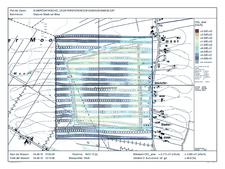
![]() Using the Rohflug evaluation software, the ODL determined during the measurement flight are entered in a geographical map.
Using the Rohflug evaluation software, the ODL determined during the measurement flight are entered in a geographical map.
Rohflug has a graphical user interface which can be used to evaluate the obtained measurement data efficiently.
Areas with elevated gamma dose rates (ODL) can thus be quickly and unambiguously identified.
The measurement data represented in Rohflug can be directly saved and printed on a geographical map.
State of 2017.08.01



